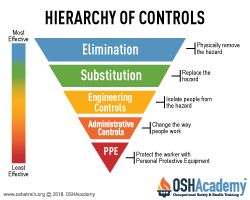Cost of Needlestick Injuries
The risks and costs associated with blood exposure are serious and real in a healthcare setting. Direct costs associated with exposure include the initial and follow-up treatment of exposed healthcare personnel. These can range from $500 to $3,000, depending on the treatment provided. Indirect costs include lost employee productivity and healthcare provider time to evaluate and treat the employee and evaluate and test the exposure source.
Costs that are harder to quantify include the emotional toll associated with fear and anxiety from worrying about the possible consequences of exposure and the cost of any associated litigation.
Hierarchy of Controls
The National Institute for Occupational Safety and Health (NIOSH) recommends that employers implement the hierarchy of controls to prevent sharps injuries. When applying the hierarchy of controls, employers must select the most effective control strategy or method to eliminate or reduce exposure to the hazard. In healthcare, engineering, work practice, and PPE controls are generally the most widely used methods to protect employees from exposure.
Elimination and Substitution
While most effective at eliminating or reducing hazards, the elimination and substitution methods can be challenging to implement. These control methods are designed to eliminate a hazard by removing exposure entirely or substituting less hazardous materials. In the healthcare setting, it may not be possible to eliminate exposure to a hazard. Similarly, it may not be possible to substitute a less hazardous material to achieve the same objective. Despite these hurdles, the elimination and substitution methods should be considered when evaluating how to reduce exposure to hazards.
Knowledge Check Choose the best answer for the question.
1-6. The size of the direct costs associated with employee needlestick injuries varies depending on _____.
You forgot to answer the question!

